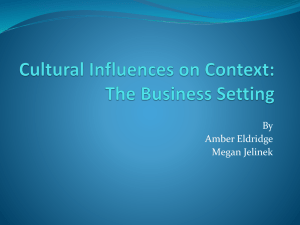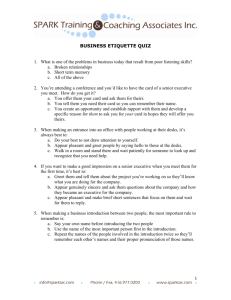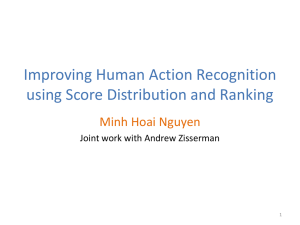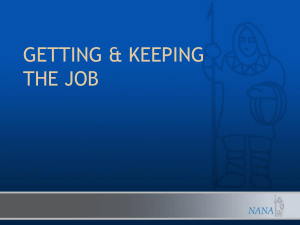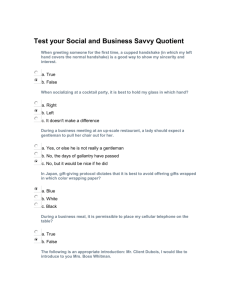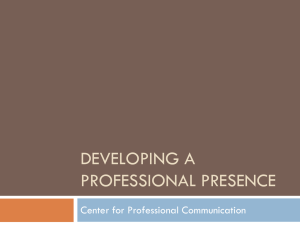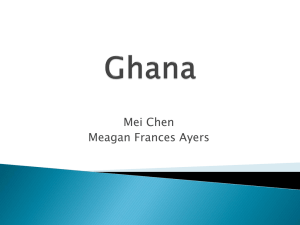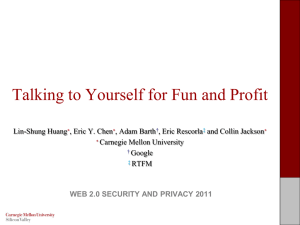Read the article………How to Shake Hands Like JFK.
advertisement
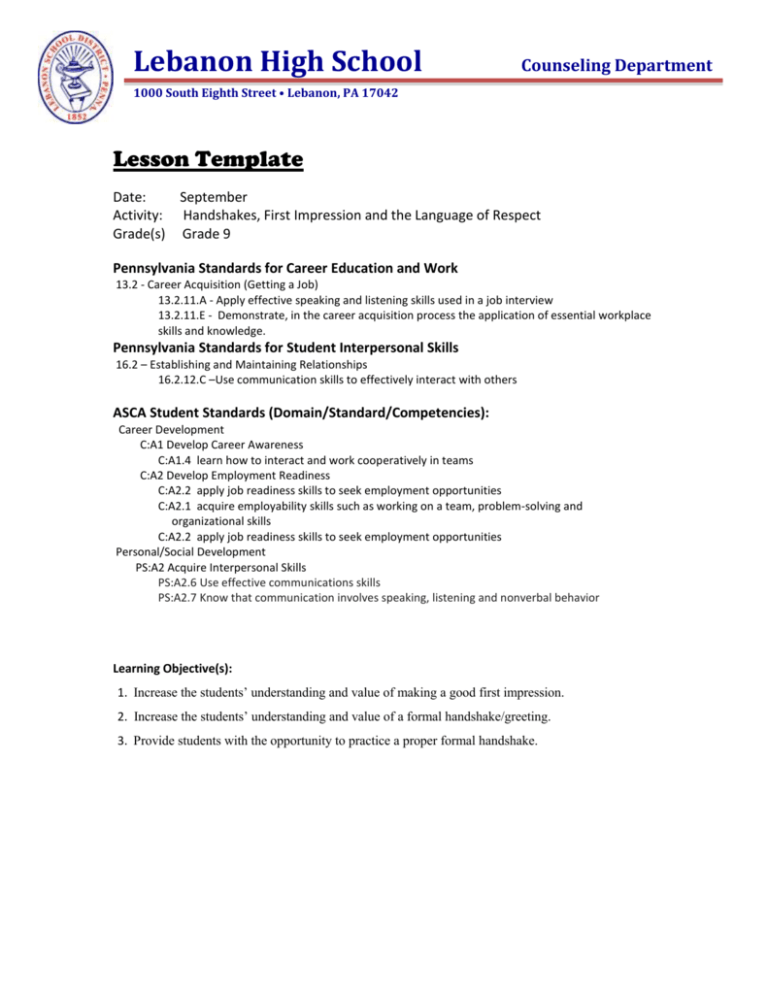
Lebanon High School Counseling Department 1000 South Eighth Street • Lebanon, PA 17042 Lesson Template Date: September Activity: Handshakes, First Impression and the Language of Respect Grade(s) Grade 9 Pennsylvania Standards for Career Education and Work 13.2 - Career Acquisition (Getting a Job) 13.2.11.A - Apply effective speaking and listening skills used in a job interview 13.2.11.E - Demonstrate, in the career acquisition process the application of essential workplace skills and knowledge. Pennsylvania Standards for Student Interpersonal Skills 16.2 – Establishing and Maintaining Relationships 16.2.12.C –Use communication skills to effectively interact with others ASCA Student Standards (Domain/Standard/Competencies): Career Development C:A1 Develop Career Awareness C:A1.4 learn how to interact and work cooperatively in teams C:A2 Develop Employment Readiness C:A2.2 apply job readiness skills to seek employment opportunities C:A2.1 acquire employability skills such as working on a team, problem-solving and organizational skills C:A2.2 apply job readiness skills to seek employment opportunities Personal/Social Development PS:A2 Acquire Interpersonal Skills PS:A2.6 Use effective communications skills PS:A2.7 Know that communication involves speaking, listening and nonverbal behavior Learning Objective(s): 1. Increase the students’ understanding and value of making a good first impression. 2. Increase the students’ understanding and value of a formal handshake/greeting. 3. Provide students with the opportunity to practice a proper formal handshake. Materials: Power Point Presentation Handshake / Language of Respect First Impression – Video links First Impressions Funny (33 sec) http://www.youtube.com/watch?v=XrWsok6FCMA Bad First Impressions-Bluefish TV (1:47) https://www.youtube.com/watch?v=ad-Dm0Ac9rA How To Make A Great First Impression (2:53) https://www.youtube.com/watch?v=eVGojczdkAI How To Make Good First Impressions (9:03) https://www.youtube.com/watch?v=626FlnKfKrg How First Impressions Work (3:10) https://www.youtube.com/watch?v=g513EUHqkfw Handshake Etiquette – Videos / Articles Handshake Etiquette (Article) http://etiquette.about.com/od/RelationshipEtiquette/a/GreetingEtiquette.htm History of Handshakes - (3:15) Mike Myers as Wayne https://www.youtube.com/watch?v=cVbAsWH-6Jk Importance of Handshakes (1:06) Pawn Shop History Chanel Guys http://www.history.com/shows/pawn-stars/videos/handshake-deal How to Give a Proper Handshake(1:28) https://www.youtube.com/watch?v=gK3I_NcXzWc How to shake hands (2:36) https://www.youtube.com/watch?v=3uBFmg5JJKI The Top 10 Bad Business Handshakes (3:00) https://www.youtube.com/watch?v=exUlCjqQsDA Secrets of Body Language (2:40) https://www.youtube.com/watch?v=0BpdQxRz2rM Access to Naviance Program for log entries/student reactions. Articles How to Shake Hands Like JFK http://www.thedailymind.com/how-to/the-perfect-handshake-how-to-shakehands-like-jfk-and-make-an-impression/ First Impressions Really Do Matter http://abcnews.go.com/Technology/story?id=69942&page=1&singlePage=true Learning Focused Schools Format Unit Essential Question: How do I make a good first impression? Lesson Essential Question How do I greet someone in a professional manner? Activating Strategy Handshake activity Teaching Strategies Power Point presentation Handshake demonstration Review of articles and videos Collaboration Extending/Refining Strategy Students will demonstrate how to perform a proper handshake/formal greeting Students will be asked to shake hands with five professionals in school that they do not know, in a formal manner. Agenda Large Group Direct Instruction – (all students) Handshake lesson and demonstration completed by instructor (15min) 1. Instruct the students to move about the room and greet/shake hands with at least three other students. 2. After observing the students handshake hands with each other inform them that there were positive and some points that could be improved. 3. Refer to the power point and complete the active demonstration on first impressions. 4. Ask students what it means to make a first impress and ask them to explain the phrase, “First impressions are lasting impressions.” 5. After the impressions discussion – follow up the demonstration of bad handshake using students as volunteers. 6. To conclude the lesson instruct the students to again shake hands with at least three people in a formal manner. 7. Assign homework – They are to formally shake the hands of five adults in school that they do not already know. Individual Online Instruction – (half class) 20 min 1. 2. 3. 4. Students will view at least 4 of the first impression videos. Students will view at least 3 handshake videos. Students will log on to Naviance – All about Me section. Students will create a new journal entry titled “First Impressions.” Your journal entry will answer the following questions Name and briefly describe a time when you made a bad first impression. Name and briefly describe a time when you made a good first impression. Why do you feel it is important to make a first impression? Why do some young people find it difficult to make a good first impression? Collaborative Activities – (half class) 20 min 1. Read the article… Study: First Impressions Really Matter Or Read the article………How to Shake Hands Like JFK. In your group discuss the 3 most important themes of the article. 2. In your group also discuss: The possible negative consequences of a bad first impression The possible positive results of a good first impression How can your body language create a good or bad impression? How can your clothing create a positive or negative impression? How can your language / slang create a positive or negative impression? 3. Your group is to create a list of: 10 positive results of a good impression 10 negative consequences of a bad impression Study: First Impressions Really Matter Sept. 22, 2004 By Lee Dye First impressions really are the most important, according to new research showing that the opinions we form in the first few minutes after meeting someone play a major role in determining the course of the relationship. If two people take an immediate liking to each other, the relationship will most likely grow over time. But if one of them is cool to the other, it's probably not going to work. That doesn't mean, of course, that subsequent developments won't alter the relationship, possibly even turning love into hate, but it does underscore the value of those first critical minutes. "It happens so rapidly it's amazing," says Michael Sunnafrank, a professor of communications at the University of Minnesota, Duluth, and lead author of a report on the research published in a recent issue of the Journal of Social and Personal Relationships. Sunnafrank and Artemio Ramirez Jr., assistant professor of communication at Ohio State University in Columbus, studied 164 college freshmen over a nine-week period. Vital Moments College freshmen are social animals, so they offered a fertile field to test out Sunnafrank's "predicted outcome value theory," which holds that we predict the future of a relationship as soon as we begin communicating with another person. And that old bromide about first impressions seemed a logical place to test the theory. If first impressions really do matter the most, then that first meeting ought to have a predictable impact, and the researchers say they found that to be the case. In fact, even after the students had been compelled to interact with each other over a nine-week period, those first impressions still played a major role in foretelling the relationship between students who had been paired together at the beginning of the study. Sunnafrank says he had thought that all that subsequent interaction would dilute the effect of the first impressions because there were many opportunities for the students to discover things they liked, or disliked, about their partner during the nine-week period. "But it just astounded me that after all that opportunity, there was such a continuing strong impact of those first impressions," he says. For the study, the students were paired on the first day of class with another student of the same sex. Sunnafrank says he avoided male-female pairings because students might be less likely to pursue a relationship with someone of the opposite sex who they had just met if they already have a romantic relationship with someone else. In other words, he wanted a clean slate, and eliminating romance made that more likely. The students were asked to introduce themselves to their randomly selected partner and talk for either three, six or 10 minutes. After the conversation they were asked to predict whether their future relationship would be one of nodding acquaintance, casual acquaintance, acquaintance, close acquaintance, friend or close friend. They also filled out a variety of questionnaires about the person they had just met. Rapid Assessments Over the next nine weeks the classroom setting required them to interact with other students, rather than just listen to a lecture, thus providing plenty of opportunity to discover new things about their classmates. At the end of the nine weeks, partners who had rated each other positively had the strongest friendships, thus establishing the predictability of that first encounter. That was reinforced by the fact that the students acted accordingly, for example, sitting closer together during class, and communicating with each other more frequently. And it didn't matter if that first encounter was three, six or 10 minutes. "The effect was as strong after the three minute conversation as it was after the 10," Sunnafrank says. "It could even be happening on first glance." "That tells you things are happening very quickly," adds Ramirez. "People are making snap judgments about what kind of relationship they want with the person they just met." But the strongest effect of all was a negative one. "It's the person who has the lower assessment of the potential for the relationship that has the strongest effect," Sunnafrank says. "If I decide you're not really someone I want to get to know, I'm going to restrict my conversation with you, even at the very beginning," he says. "I'm going to look away, I'm not going to seek you out when I come into the classroom. So I'm giving you signs that I'm not interested, which is going to make you uninterested in me. And you're going to act in the way I predicted, which is not positive. "If I'm not interested in you, I'm eventually going to prevail." Quick Change But what works for college freshmen may not work for the rest of us. Sunnafrank notes that freshmen tend to be aggressive in the pursuit of new friendships, and that changes over time, at least for most of us. "In most situations in life, our time is pretty much claimed by work and family matters, so even when you meet people you really like, chances are not much is going to happen. As life goes on and social networks become solidified, acting on that first impression becomes less likely," he says. And as they say, nothing lasts forever. We all know people we disliked in the beginning, but learned to like as we got to know them, and vice versa. So relationships are not always predictable, regardless of how strong that first impression may have been. "Surprising events," as Sunnafrank calls them, can change a relationship in a hurry. "If you stab someone in the back …" That reminds me of a very elegant lady who taught my English lit class in college. A student complained one day about something we had read in which love had turned to hate. How could that be possible? "Oh, Miss Evans," the professor said, always as polite as she was eloquent, "don't you know the line that divides love from hate is a very fine line indeed." Lee Dye’s column appears weekly on ABCNEWS.com. A former science writer for the Los Angeles Times, he now lives in Juneau, Alaska. The Perfect Handshake: How to Shake Hands Like JFK and Make an Impression image thanks: jfklibrary.org Did you know that John F. Kennedy commissioned an entire study to determine the most effective handshake? And with good reason! More than just a sign of friendship, your handshake speaks volumes about who you are as a person. A soft hand shake can indicate insecurity. A quick-to-let-go handshake can convey arrogance. Kennedy knew that he would be shaking hands with the world’s most powerful men and women and as such he wanted to get it right. We should endeavor to do the same. In this post I am going to give you a few tips on how to shake hands like JFK. We all know that first impressions last and it is often your handshake that makes the first impression. The origins of the handshake? As with most human behaviors, the origins of the handshake seems to predate recorded history. We can never know for certain where the handshake originated or why people started doing it. However, there are a few plausible theories. The most widely accepted theory is that hand shaking originated in medieval Europe where knights would extend their hand to other knights in order to show that they had no weapons hidden or concealed behind their back. This seems to fit quite nicely with the modern version of a handshake – two people using one single gesture to convey friendship, openness and nonharming. Regardless of its origins, the handshake has become a solid part of modern life and culture. People of all races, shapes, sizes and status use the handshake as a way to greet a person, make an agreement or say goodbye. Why is our handshake so important? As I mentioned earlier, the way you shake hands speaks volumes about who you are as a person. For some people a handshake is just a useless formality but to others it is a massive indication of a person’s depth of character, trustworthiness and strength. When you shake hands with a person you are doing much more than saying “hello”. You are saying “this is who I am“. Imagine a leader like John F. Kennedy who was in power during a time of worldwide nuclear uncertainty. A weak handshake with a Cuban or Soviet dignitary could create great problems for the United States as a whole. A strong handshake, on the other hand, could convey confidence, stability and trustworthiness and open up new dialogues and friendships between leaders that have long been opponents. If you are a business person your handshake can be the maker or breaker of a big contract or deal. If you are a doctor or health care provider your handshake can fill a patient with confidence and trust. It is extremely important for all people, regardless of your race or way of life, to learn how to shake hands with meaning. The handshake that lost an election In 2004 there was a big election in Australia. The current Prime Minster was John Howard and he had lost a lot of public trust after agreeing to follow Bush into Iraq and Afghanistan. Many people thought he was going to lose the election after being in office for years. His political opponent in the election was a newcomer on the scene called Mark Latham. He had injected a bit of vitality into the opposition party and local political commentators thought he had a good shot at getting into power. But one handshake ruined it all. A few days before the election John Howard and Mark Latham met at a radio interview and Latham shook the Prime Minister’s hand in a very aggressive manner – pulling him close and staring him down. Footage of the handshake spread like wildfire and it was all over the news for weeks. Although public opinion of John Howard was at an all time low, people thought Mark Latham was a bully for the way he “roughed up” the PM. Latham lost the election. Lost it in a landslide. After the election the polls showed that the major reason people voted against Latham was because of his overly aggressive handshake. One handshake lost him the election. This is the only footage of the handshake that I could find. It starts at 1:54. The short bald guy on the right is Prime Minster Howard. Take a look at how Latham pulls him right up close and stares him in the eyes. This is how you should shake hands if you want to lose an election. How to shake hands like John F. Kennedy JFK’s study into handshakes found that the most effective handshake was the “double handshake” where the left hand is placed under the right hand to “cup” the clasped hands. Positioning the left hand in this way adds an extra dimension of enthusiasm and trust to the shake and conveys a great sense of friendship and trust in the other person. However, the actual shaking of the hands is, in reality, only a small part of the business of shaking hands. Here are a few tips on how you can make the perfect handshake: 1. Look the person in the eyes The position of your eyes is almost as important as the hands themselves. In fact, many leading business men and women will tell you that it is your eyes that convey the most about you during that initial point of contact. If you look down to the ground you are telling the person that you are shy, nervous and even untrustworthy. Avoiding eye contact is behavior typically seen in someone who has done something wrong and feels ashamed of guilty. Looking the person in the eyes shows that you are engaging them. It shows that you are interested in this meeting and you are glad to see them. Always make sure you look a person in the eyes when you shake their hand, no matter how busy or brief the handshake might be. 2. Use a firm grip The key element of a good handshake is a firm grip. A soft grip doesn’t speak very good things and sometimes people will take it to mean that you are weak of character or not really interested in the person with whom you are shaking hands. A firm grip, on the other hand, shows confidence, strength and enthusiasm. Is shows you are keen to get involved with the person and you are firmly committed to being there. Be careful not to go overboard though, a bone crushing grip can appear extremely arrogant. 3. Don’t be too hasty A handshake should be inviting but not rushed. When you rush a handshake you inevitably get caught in that embarrassingly halfhearted position where neither person is really gripping properly. When you go in for a handshake offer your hand with your fingers straight and your thumb high and make sure you do not grip until the person’s thumb is firmly locked next to yours. You should also not be too hasty in letting go. Germ freaks like Donald Trump often let go quickly and it is seen by many people as a big insult. If you can’t even shake my hand how can we develop a trusting relationship? Make sure you hold on for long enough to show the person that you are excited to meet them. 4. Don’t shake too much I know it is called a handshake but the term is a little bit misleading. One of the worst handshakes you can get is the one where the person shakes your arm like they are trying to tear it off. Not a good idea. Perhaps think of it more as a handgrip instead of a handshake. It is fine to do two or three small shakes but that is enough. Too much shaking can convey over-excitment and in some cases it gives the impression that you are desperate. You never want to be portraying yourself as desperate, even if you are. Make sure you don’t overdo the shaking. 5. Make correct use of the left hand image:pennlive.com JFK thought the best place for the left hand was cupped under the shaking hands. However, this might not always be appropriate. The JFK cupped left hand is really quite an intimate grip. It is something you would do to someone you really admire or an old business friend that you haven’t seen in years. JFK correctly used it on foreign leaders, party donors, etc. Personally, however, I do not think the double handed shake is always appropriate. For example, I would never use the JFK double shake when introducing myself for the first time to a new client who was older than me. It can come across as a little enthusiastic. But you should use the left hand. Humans are intimate beings and (with a few rare exceptions) love to be physically interacted with. When I meet a new client I give a firm shake with my right hand and use the left hand to touch them on the shoulder or elbow region. If you are shaking hands to say goodbye to someone you can use your left hand to pat them on the upper back as they walk away. This physical details are extremely important. But sometimes the “correct” use of the left hand is not to use it at all. You will find yourself in certain situations where it might not be appropriate to do anything other than give a quick shake with your right hand. Make sure you use your own intelligence to determine the best use of the left hand. One place where the JFK shake is really very good is when you have just reached and agreement or a deal with a person and you want to express your happiness. 6. Use your speech in conjunction with the handshake Remember, the act of shaking hands is more than just the two hands meeting. It involves eye contact, shoulder touching, a firm grip, and many other factors. One thing you should never forget to do when shaking someone’s hand is use your speech in conjunction with the handshake. The most important speech to remember when shaking hands is the person’s name. ALWAYS call them by their name and never use lazy substitutes like “mate”, “brother” or “dude”. People love to hear their own name. When you shake a person’s hand and greet them by their name you are effectively saying “you are important enough to me that I bothered to remember your name”. Using a word like “mate” shows you don’t really care. Remembering people’s names at golf with my father A long time ago my father (a big time business man) took me out to a golf game. He told me I would be meeting a lot of high powered men from around the country. He told me to pay attention to their names and remember them as if my life depended on it. He also told me to pay attention to the men who greeted him by his name and the men who greeted him by saying “mate” or some other nick name. As it so happened, the guys who used nicknames were 100% of the time the guys that nobody else in the group really interacted with and on several occasions they were even disparaged as being untrustworthy. In the car on the way home my father told me that 50% of a business deal is done in the initial handshake and remembering the person’s name is the most important part of that handshake. He was on to something. You can take this theory one step further and remember a fact about the person’s life. If, for example, you know that the person just bought a new Mercedes Benz you can shake their hand and say something like, “Great to see you again John. How’s that Mercedes treating you?”. This is a fantastic way to show you are interested. When you use your speech in conjunction with the handshake you are interacting with the person physically, verbally and emotionally. A triple header handshake like this leaves an impression. 7. Remind people of your name straight away Another trick my father taught me is to remind people of your name as soon as you shake their hand. It is important to realize that other people want to remember your name just as much as you want to remember theirs – nobody likes forgetting a name. If you have met a person before try to give them a little reminder as you shake their hand. You could say something like, “David Johnson. Great to see you again John.” This will help to put them at ease and hopefully make the meeting a little more streamlined. Conclusion The handshake is extremely important to our society. Peace treaties have been promised over a handshake. Wars have been ended by a handshake. Great business deals have begun because of a good handshake. Make sure you follow the tips above whenever you shake someone’s hand. A good handshake is a first impression that will last a long time in person’s mind. SOURCE The Daily Mind The Perfect Handshake: How to Shake Hands Like JFK and Make an Impression http://www.thedailymind.com/how-to/the-perfect-handshake-how-to-shakehands-like-jfk-and-make-an-impression/ Evaluation Process Data - “What did you do for whom?” (number of lessons or group sessions and students involved) ________________________________________________________________________________ ________________________________________________________________________________ ________________________________________________________________________________ Perception Data - “What do people think they know, believe or can do?” (surveys or assessments showing knowledge gained, competencies attained or attitudes held) ________________________________________________________________________________ ________________________________________________________________________________ ________________________________________________________________________________ Outcome Data - “So what?” Big Picture Graduation Rates/Detentions/Etc (how are students measurably different as a result of the activity) ________________________________________________________________________________ ________________________________________________________________________________ ________________________________________________________________________________ Implications ________________________________________________________________________________ ________________________________________________________________________________ ________________________________________________________________________________ Perception and Outcome Survey Questions – How are students different? I believe it is important to make a good first impression I know the proper way to shake hands with an adult I feel comfortable in school. I feel comfortable interacting with adults in school
